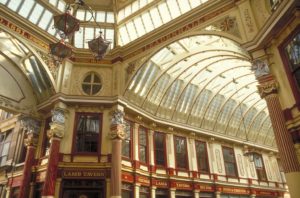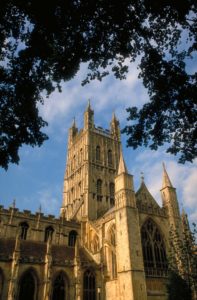The medieval settings and scenery chosen for the Harry Potter movies can be at turns gray and ominous, sunlit and majestic. With a few good friends, leave the muggle world behind. Each film location evokes the essence of England and Scotland. Plus: Celebration Traveler Guide Hip Travel: England, Scotland.
By Donna Peck
 Have you grown up with the Harry Potter books and movies? Millions have accompanied the world-famous fictional hero from his cupboard under the stairs to the siege of Hogwarts. In the final movie, Harry saves the wizarding world from the snake-faced villain. Has it all ended? Not while you can still visit the film locations throughout England and Scotland.
Have you grown up with the Harry Potter books and movies? Millions have accompanied the world-famous fictional hero from his cupboard under the stairs to the siege of Hogwarts. In the final movie, Harry saves the wizarding world from the snake-faced villain. Has it all ended? Not while you can still visit the film locations throughout England and Scotland.
Roam the cities, villages and highlands that appeared in the movies. Scenes of Hogwarts draw on Britain’s medieval past. Cathedrals (Gloucester, Durham), colleges (Christ Church College), cloisters (Lacock Abbey) and castles (Almwick) are more impressive in person. So is the Scottish Highlands as the Jacobite (Hogwarts Express) steams past Britain’s highest mountain, deepest loch and most photographed viaduct.
Take a few good friends (who may have imagined themselves witches and wizards in their youth) and leave the muggle world behind. Not only the Harry Potter movies, but the history and heritage of Britain come alive in these settings.
Harry Potter in London
London is a Harry Potter gold mine. British Tourism has thoroughly mapped the Harry Potter trail and distributes a handy brochure. At King’s Cross Station, pretend to push the trolley through the brick wall at platform 9 3/4, the portal to the wizarding world. For scenes from The Sorcerer’s Stone, stop at the London Zoo’s Reptile House where Harry freed the boa constrictor. The Lewis Chessman, used as models in the same movie, are in the British Museum.

The entrance to the Leaky Cauldron and Diagon Alley is the entrance to Leadenhall Market. (Ask the locals to recommend a good cafe for treacle tarts.) The interior of Gringotts Bank was filmed at Australia House.
The hunt for Prisoner of Azkaban scenes takes you to Borough Market near Tower Bridge. The Leaky Cauldron was filmed at the Market Porter Pub. The tower staircase from the movie is inside St. Paul’s Cathedral.

Walk along the Thames River to recall the flying scene from the Order of the Phoenix. In the opening scene for the Half-Blood Prince, the Millennium Bridge—a footbridge crossing the River Thames—buckles, sways and snaps in two.
In the Deathly Hallows Part 1; Harry, Ron, and Hermione apparate to Piccadilly Circus and fight Death Eaters in a cafe. Pick a properly seedy cafe for a cappuccino. Then it’s time to pack for Hogwarts.
Hogwarts scenes filmed in medieval England
Over the past decade, Britain’s treasure trove of medieval colleges, cathedrals and castles have stood in for Hogwarts. At Oxford’s Christ Church College, founded in 1525, you step into Hogwarts dining hall. You’ll also see the large stone staircase leading into the great hall and the school’s moving staircases. The infirmary scene at the end of the Sorcerer’s Stone was filmed at the Divinity School, with its magnificently vaulted ceiling (circa 1462). In the Goblet of Fire, Draco was turned into a ferret in the courtyard.
Duke Humfrey’s Library at the Bodleian Library stars as the Hogwarts library and the Restricted Books section which Harry entered concealed under his invisibility cloak. Its massive dome and collection of more than 6 million volumes is a spine-tingling sight.
As you turn toward Oxford village, imagine that you’ve conjured the Room of Requirement: it has everything you need to quench your thirst, fill your stomach and rest your head.

Gloucester Cathedral, the ancient Norman church consecrated in 1100, was used more than any other setting for Hogwarts interiors. The Chamber of Secrets scene with the large troll and the warning “Enemies of the heir, beware” were filmed here. Nearly Headless Nick and Moaning Myrtle don’t roam these halls, but visit the crypt and see if the you don’t get an icy chill. Monks from the old Gloucester monastery rest uneasily here.
Durham Cathedral, high atop a hill in the university town of Durham, also stars in the Potter films. The scene with Harry and Hedwig in the Sorcerer’s Stone was filmed in the cloister courtyard. This cathedral contains the tomb of the Venerable Bede, the 8th-century monk who wrote the first history of England. Continuing to write for the rest of his life, he authored 60 books, most of which have survived. Hang around for the Anglican evening service. When the choirboy sopranos sing, even the stone walls seem to listen in rapture.

In Lacock village, visit the medieval rooms of Lacock Abbey where Hogwarts classroom scenes were filmed. The sacristy was used for Potions class, the Warming Room for Defense Against the Dark Arts. The Chapter House was used for the scene with the Mirror of Erised. In a hallway, the scene where Harry is picked for the Quidditch team was filmed. Its intricate details, gargoyles and Gothic arches have been carefully preserved by centuries of owners, built on the foundations of a former nunnery.
In the historic market town of Alnwick sits the massive Alnwick Castle, its exterior unmistakably the walls of Hogwarts and its interior Hogwarts school in the first two movies. Its wide green lawn was the Quidditch field. Scenes of the Hogwarts flying lessons and the Whomping Willow were filmed there.
Outside the main garden wall lies the Treehouse, a wooden structure with turrets and suspended walkways: one of the largest treehouses in the world. The Percys have lived in the castle since the 11th century and has a long history of battles, betrayals and intrigue, not unlike the Harry Potter chronicle.
Harry Potter and J.K. Rowling in Edinburgh

The fact that the story poured from the pen of a single mother living on government benefits in a tenement flat in Edinburgh makes her achievement more laudable. J.K. Rowling wrote many of her early novels in the coffee houses of Edinburgh while her daughter slept in a stroller.
Visit the back room of the Elephant House cafe overlooking Edinburgh Castle: J.K Rowling’s favorite spot while she worked, nursing a cup of house coffee. The stories came “fully formed” into her head, she says, during a train journey in 1990. Hermione is loosely based on herself, at the age of eleven. Albus Dumbledore, Hogwarts headmaster was inspired by Alfred Dunn, the headmaster at a school she attended.
Don’t miss Edinburgh’s Royal Mile. Castlehill and Canongate streets are a cobbled maze of narrow lanes and ancient shop fronts. You’ll feel like you slipped through a portal into Diagon Alley.
J.K. Rowling checked into the Balmoral Hotel to finish writing the last book of the series. Rowling said on finishing Deathly Hallows, “I never dreamed I could feel simultaneously heartbroken and euphoric.”
Harry Potter in the Scottish Highlands
The scenery of the Highlands can be dark and foreboding; at other times sunlit and majestic, just like Rowling’s tale. She lives in a country house in Aberfeldy on the River Tay not far from Fort William, the departure point for the ‘Hogwarts Express.’ In real life, you board the Jacobite Steam Train which runs 42 miles from Fort William to Mallaig. En route to the coast, the train passes Loch Eilt which was used as Hogwarts Lake. When Harry and Ron miss the train and fly to Hogwarts in a car, they drive over Glenfinnan Viaduct’s 100-foot high arches.

You’ll also recall the train halts on the viaduct in a vaporous mist, as soul-sucking Dementors search the train for Sirius Black.
Stretch your legs in the rugged countryside of Glen Nevis. At Steall Falls, the first task in the Triwizard Tournament was filmed when Harry wins the battle with a Hungarian Horntail dragon.
After an invigorating hike, check into the Clachaig Inn. Across the street, a trail leads to film locations in the Prisoner of Azkaban. The craggy, desolate hillside in the mountains of Glencoe Close was the backdrop for Hagrid’s Hut. At dinnertime, try Scotland’s national dish: haggis, neeps and tatties. Haggis is a kind of sausage, or savoury pudding; neeps are turnips with ginger and tatties mashed potatoes with nutmeg.
Author
 Donna Peck entered J.K. Rowling’s fictional wizarding world with her 13-year-old daughter. “Our favorite spell was Expecto Patronum to repel anything nasty. Our favorite potion for a perfect day was Felix Felices. And to this day our most-admired heroine is J.K. Rowling.”
Donna Peck entered J.K. Rowling’s fictional wizarding world with her 13-year-old daughter. “Our favorite spell was Expecto Patronum to repel anything nasty. Our favorite potion for a perfect day was Felix Felices. And to this day our most-admired heroine is J.K. Rowling.”
Photography: Visit Britain






Leave a Reply